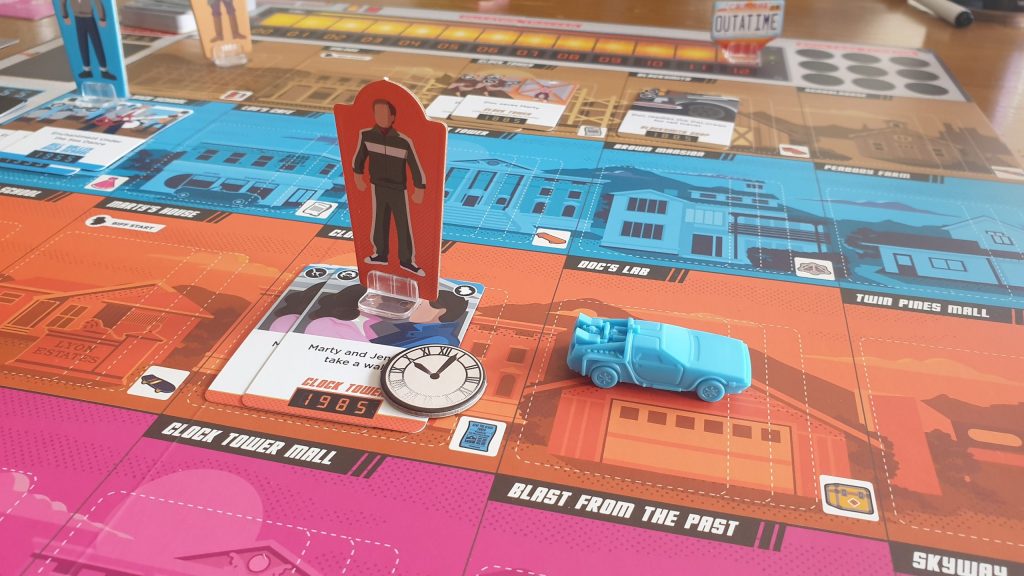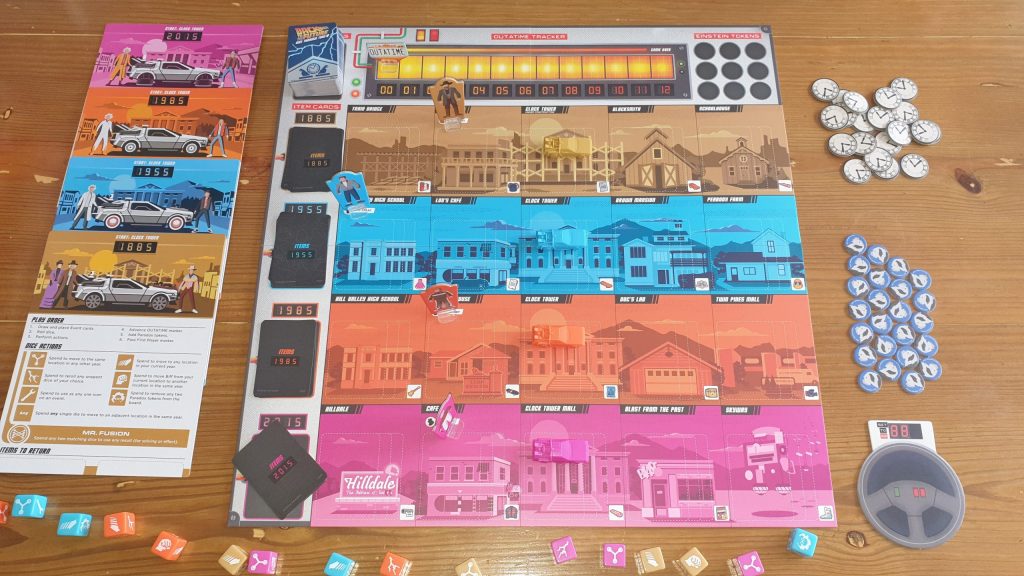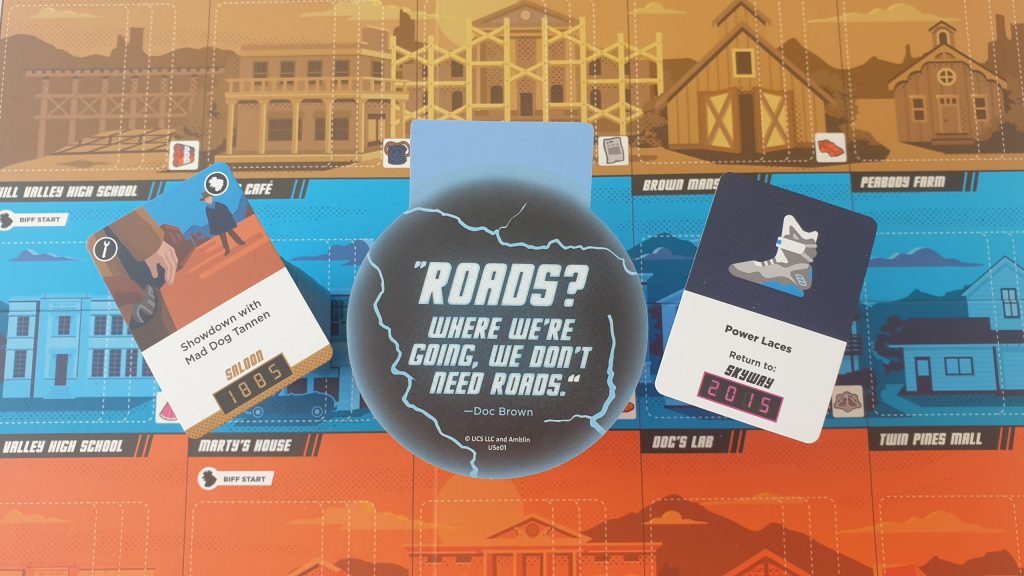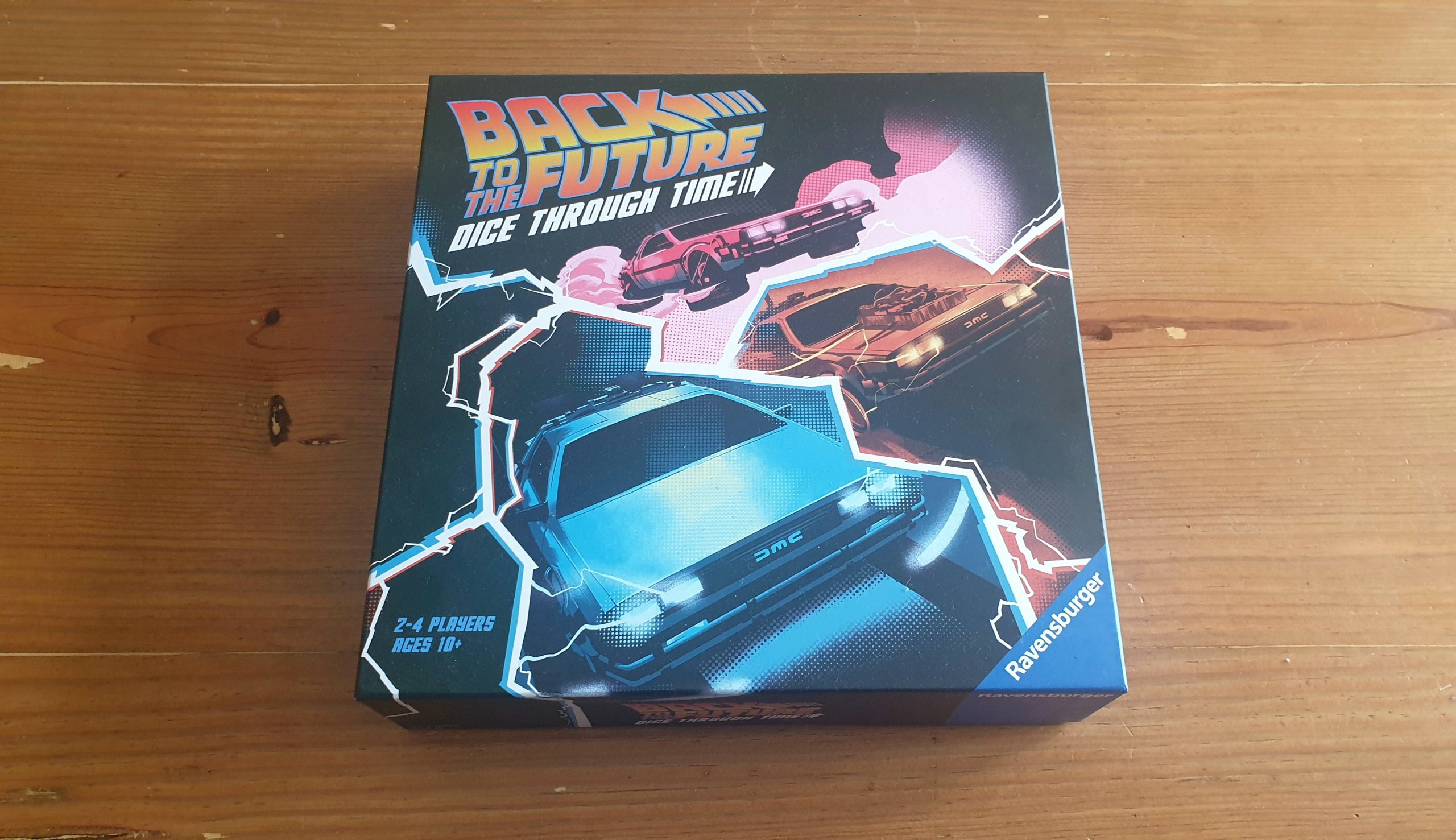Back to the Future: Dice Through Time is a brand new cooperative board game from publisher Ravensburger. Designed by Ken Franklin, Chris Leder and Kevin Rodgers, this is a Back to the Future themed dice rolling title with pick up and deliver style mechanics – playing with 2 – 4 players in around an hour. Just like with the films it isn’t just Hill Valley that could be changed if things aren’t returned to their original place in the timeline! However, is this a game you’ll want to spend time with? Let’s find out!
Being a cooperative adventure the team of players will be playing against the board itself, playing as Doc and Marty across 4 the four years in time that the movies are set. Each player takes control of a different DeLorean, though naturally they won’t stay in the same time period. Depending on the difficulty level a number of item cards are placed for the players to retrieve in each time period. The Biff lineage are placed in their starting locations in each year, with the DeLoreans all starting at the clock tower location.
Each round sees 6 phases occur. Firstly, a number of event cards are revealed. These are placed onto the denoted location in the denoted year. Ranging from Marty skateboarding to school to Griff trying to recruit Marty Jr. they are all events that occurred during the trilogy, and they all need fixing! Most events will have one symbol on them that matches a dice symbol, with some having two and others having a Biff symbol that sees that time period’s Biff moved instantly to the card blocking the event from being fixed.

In phase 2 players get to roll their dice, and can choose to reclaim any dice they’ve left on the board previously. Starting with whoever has the first player marker, each player then spends as many of their dice as they wish performing the indicated actions. Players will be travelling forwards and backwards in time by spending flux dice, travelling to other locations in their time period by spending arrow symbols and even punching Biff with fists.
When players get to locations with events they can also assign dice with matching symbols to fix the events. Unfortunately, if two or more events are in the same location and time they must all be simultaneously completed. Fixing events throughout time will see the event cards removed from the board, along with a paradox token if one is at the location – both of which are bad for players if left unchecked. More importantly it unlocks the path to victory with an item earnt if one is still available from that year in time.
The aim is then to return the item to its original location and time period. For example, this could see the hoverboard returned to 2015 at the clock tower mall. By returning an item players are one step closer to winning. Not only does the outatime marker move back one space on the tracker, players randomly draw an Einstein token. Einstein tokens feature one of the dice symbols on their reverse, which is hidden knowledge until it is selected. On a future turn any player may spend as many Einstein tokens as they wish, performing the actions as if they were bonus dice. It’s not much but they can be the difference between breaking time and saving it!
To make matters a little easier is the concept of the dice rippling through time. On a player’s turn they can choose to leave any unspent dice on the board, at their location. Other players can then spend those dice symbols at the location of the dice, or at the same location in a future time period. Dice left cannot be used in a year before they were left – that’s not how time works.

Once everyone has had their turn the Outatime marker will advance. Players look at the board to see which year has the most locations with events still on them. This number, combined with the number of paradox tokens in that year, equals the number of spaces the marker moves. If this sees the outatime marker reach the end of the 12 space long tracker the game is lost, and the universe is doomed. If that wasn’t enough to see players lose, the locations that have an event in that year then gain a paradox token, unless they already have one. The final phase is simply to pass the first player marker on to the next player and the next round begins.
The concepts of crossing and weaving timelines are actually captured in Back to the Future: Dice Through Time. Items need to be returned to their right places to stop splitting timelines and avoiding other versions of the DeLorean duo feels like it is straight out of the films and Doc Brown’s notebooks. Right down to how Biff’s family both past and future are all ready to trip up Doc and Marty for their own gain, it comes straight from the movie scripts.
Perhaps it is due to sticking so close to the events of the movies that 3 identical copies of each event are in the deck, though the symbols to complete them change. Despite being the same events the cards could have had slightly tweaked artwork or another aspect of that scene depicted. This is as far as the component complaints go, with vibrant colours used for the player colours and the main board. The DeLorean miniatures are exactly what every Back to the Future fan would want as a player piece and the theme really shines from everything in the box. There is even a letter from the Doc himself on the reverse of the board, which is something I’ve never seen before.

The events building up and the various Biffs stopping players from returning items to their proper places helps the game have some tension. Turning what would be an easy to complete objective into one that may even require a few communal Einstein tokens to complete once Biff is shoved to a different location. However, the way that the paradox tokens build up, making the outatime marker move faster, turns things that would be a minor inconvenience into something that could lose you the game if left unchecked. For those who play other cooperative games it is akin to leaving a city in Pandemic on the verge of an outbreak. On those final turns of the game players can risk not clearing it and attempting to get the items back or go out of their way to fight for another round.
With four dice each there can be a number of turns where you simply don’t roll what you need. Some of this misfortune is fixed via the Einstein tokens, or via Mr. Fusion by spending two identical dice to be any one symbol. The other opportunity to players is the lightning symbol on the dice. This allows players to reroll any unspent dice. Alas, spending a dice to reroll the rest can often leave the player unable to fix multiple events at a location. When the tension is being turned up there is nothing worse than a full turn that feels wasted. Starting with a reroll symbol in the form of an Einstein token could alleviate this, at least for while learning the game.
Coming with multiple difficulty levels there is some reason to return when you’ve already managed to save the day once. Up to that point the drive to win is certainly there, as each playthrough players get that bit further before defeat. After a win or two though the want to replay does ebb away, making you more want to watch the films that play again. From one difficulty to the next the only difference is the number of items that will need to be returned to their rightful place in time and space. Therefore there isn’t a huge shift from game to game, with only the order items or events come out spicing things up.
Back to the Future: Dice Through Time is one of those board games that truly embodies the theme it is portraying. From the need to return items to save the world from time paradoxes to not wanting to run into the DeLorean duo from other timelines it is all there. There is the spark that makes you want to play again, at least up until you are successful in beating the game. Without that something to tweak the gameplay though it is a game that will then sit on the shelf for a little while before it drags you back in for more.
(Editor’s Note: Back to the Future: Dice Through Time was provided to us by Ravensburger for the review.)

